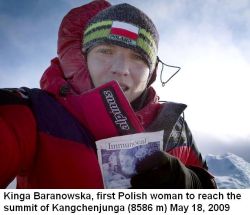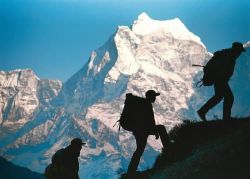I show you few events from 2007 ; full info - Explorersweb : Year-In-Review - by Explorersweb.com
Winter climbs
“In recent years a total withdrawal from wintertime climbing can be observed in the Tatras, the Alps, and the Himalayas," Krzysztof Wielicki wrote in his manifest, "If you do not take up the challenge, we shall have to take it on our old shoulders, without a guarantee of success." The Polish climbers did exactly that. After climbing for 38 days and 3300m up difficult terrain to 6000m, "Above that point there was only freezing hell,” they finally called off their gutsy Nanga Parbat winter expedition.
Simone's and Shaheen's equally cool attempt on winter Broad Peak ended after climbing without fixed rope in 40 below, howling winds and a 13 hour marathon climb final. Both are back again this season for another try.
Everest 2007
Kennedy's words "You must do it not because it's easy but because it's hard," are often met by a "why?" these days. On Everest only one off-normal route climb was attempted this year. Instead, there were even more reality shows made. Stories of thefts and failing oxygen continued; Everest Chinese side also offered armed guards patrolling BC and arrests of protesting Americans in preparation for the Olympic torch to be put on top of Tibet.
Kazakh Vassily Pivtsov and Maxut Zhumayev summited Everest well ahead of any other foreign climber this year – without O2. The two top high altitude mountaineers were instantly criticized by amateur climbers for taking such a risk. Nives Meroi and Romano Benet also summited Everest via the North Col route without supplementary O2 support. This was their 10th, 8000er. Also Luis Felipe Ossa bagged an Everest summit without supplementary O2, becoming the first Colombian to do so.
Those were the few no 02 ascents on the record 526 Everest summits in 2008.
Seven people lost their lives on the mountain, by unclear causes. A 62-year-old Japanese collapsed shortly after starting descent. An Italian went missing without anyone noticing. Only two climbers died in actual falls - on the difficult SW face.
Two high altitude rescues took place: Found almost unconscious on Everest south side at 8300 meters, with severe frostbite and altitude illness, Nepalese Usha was brought down by climbers from another expedition. On Everest north side, Italian mountaineer Marco Epis spent two days unconscious in the snow next to camp at 8300 meters. Unrelated Russian mountain guide Sergey Kofanov lowered him down to the North Col together with a Sherpa and a French female climber.
At 71, Japanese Katsusuke Yanagisawa became the oldest person to summit the peak. At 18, Samantha Larson from California became the youngest 7 summiteer. A no arm attempt was aborted due to crowding and Dutch Iceman Wim Hof set a record by climbing to 7.400 meters in shorts.
The climbs
In the Karakoram mountains mostly Eastern European climbers shot for new routes on K2.
Chinese female climber JiJi grabbed the summit of Hidden Peak for her husband Rena, who perished enroute there two years back. Austrian Gerlinde Kaltenbrunner summited Broad Peak - her tenth 8000er. Spanish Edurne Pasaban followed close behind: Broad Peak becoming her ninth 8000+ summit.
Santiago Quintero, teaming up with Carlos Pauner, topped out BP as well, despite having lost all his toes to frostbite on a previous Aconcagua expedition.
Italian Silvio “Gnaro” Mondinelli bagged his 14th 8000+ meter summit on Broad Peak, becoming only the 13th climber in the world to complete the dangerous quest and the third Italian, after Reinhold Messner and Sergio Martini. Moreover, Gnaro is only the 6th person to have made it without supplementary O2.
Piotr Morawski, Peter Hamor and Josef "Dodo" Kopold reached the summit of Nanga Parbat following a fast and persistent attack. French climber and skier Jean-Noel Urban was on the peak as well, hoping the ski down following his spring Everest summit and some ski turns there. Unfortunately, Jean-Noel was turned back in exhaustion after having to not only climb, but also carry all his skiing gear up the snow-packed slopes of Nanga Parbat.
Italians Karl Unterkircher, Daniele Bernasconi and Michele Compagnoni summited GII via the north spur, traversing down the south side and achieving the first complete ascent of the mountain’s north side. Earlier Karl Unterkircher and Hans Kammerlander summited the 7,350 meters-tall Jasemba on their third straight year attempting the peak. The two men climbed 2,000 vertical meters non-stop to the summit and back, in a 20-hour push.
Closing stats and fatalities
In 2007, Broad Peak had the most summits (77) followed by Spantik (44) and K2 (29). Nanga Parbat and the Gasherbrums shared 48 summits.
With the new summiteers; AdventureStats registered a total of 269 summits on K2, and 65 casualties, setting the death to summit rate on 24%. 23 of the mortal accidents on the mountain were due to climbers falling, a much larger number than those (13) who died in avalanches. In 2007, Korean team member Nima Nurbu from Thame fell to his death from the Bottleneck. Italian climber Stefano Zavka went missing after summit, last seen above the Bottleneck without means of communication.
A total of 5 climbers perished in Karakoram this summer; two on K2, one on G1 and two on G2 in an avalanche which left Hirotaka Takeuchi injured.
Himalaya fall 2007
The fall Himalaya season sported very few summits due to serious weather. Shisha Pangma had a handful of summits via the south face, but was left unclimbed on the normal route. Except for that and Cho Oyu, only Jannu was summited, in a spectacular ascent.
Valery Babanov and Sergey Samoilov (the Russian guide who rescued the Italian climber on Everest this past spring) reached the top of Jannu on October 21, placing a new route on the west ridge in alpine style. The final push took place after a night of heavy snow fall spent sitting out in the tent without sleeping bags at 7600 meters.
Tomaz Humar performed a remarkable climb on Annapurna's south side, solo and in Alpine style. Unfortunately, his accomplishment was initially shadowed by criticism, until fellow climbers came to his aid praising the ascent.
Ski descents led to an ExWeb 8000+ ski/board mountaineering gear special: Stay warm and travel light was the message from Italian Emilio, Swedish Fredrik and American Tyler.
Incredibly, all 8000+ climbers survived the fall Himalaya season, except for American Ray Yeritsian who suffered a ruptured artery in Nyalam (3750m) enroute to Shisha Pangma base camp.
Nangpa la - to be continued...
In a large Men’s' Journal article titled "Murder at 19,000 feet", details were printed about last year's events on Nangpa La. "Paul told me you sent an email to ExplorersWeb," Russell Brice yelled at Luis Benitez according to the article, "Are you fucking crazy?"
“A climb without humanity is not a climb anymore,” Pavle Kozjek said, referring to Nangpa la. Word is there were shootings in the pass also this fall Cho Oyu season, but the rumor is unconfirmed.
ExplorersWeb's special story about Nangpa La and the upcoming Olympic Everest event spurred tons of emails. Meanwhile, another report showed that the battle between ambition and humanity continues on the commercialized 8000er mountains:
"At my usual rest spot, just below the big ice cliff, I saw a man hunched over sort of whimpering or crying," Chris from Field Touring Alpine reported from Cho Oyu. "He told me he had just summited and that his partner had fallen and broken his leg while descending."
Chris spotted an unrelated expedition lowering the injured climber down a steep slope. He aborted his summit push and offered to help. "Alex (Abramov) handed me a rope and in his thick Russian accent said 'you short rope him, keep head up hill'." The rescue went on while many climbers, including a mountain guide walked past without a word and two supposedly 'very famous' alpinists passed going up without even turning their heads.
2008 preview
Chinese 1975 Everest climber Xia Boyu lost both his legs in un-selfish act on the mountain. Xia's climbing spirit would get a serious reality check in the 30 years of hardship and pain that would ensue. Yet when a number of amputees began to scale Everest in recent years; Xia was urgently watching. The 55-year-old climber now wants to return to the peak; facing a challenge that may prove tougher than the climb itself: To find support and sponsorship in a political and financial climate not exactly famous for its interest in disabled people.
Only three Americans have done it before - and no American woman yet: But next fall, American Tonya Riggs and high altitude filmmaker Brad Clement will take their chances on the highly dangerous Annapurna. The two recently summited Everest together.
Nepal announced reductions in climbing fees off-season. Pakistan's reduced climbing fees will continue in 2008. China will be strictly vetting each and every Everest expedition; 3 nationalities per expedition including Nepali staff are allowed, all documentation has to be sent at least two and a half months in advance, and only well organized, well supported and fully equipped teams will be allowed to climb is the word.
Simone La Terra and Mehrban Karim have aborted their attempt for a winter ascent of Nanga Parbat. Simone Moro is once again teaming up with Shaheen Baig in an attempt to bag Broad Peak's first winter ascent. A joint Kazakh/Italian team will depart on December 5, 2008, for a winter attempt on Makalu.
The Himalayan Trilogy dream team (Piotr Pustelnik, Piotr Morawski and Peter Hamor) are coming back to Himalayas next spring. Over only 2 years; they plan the north-west face of Annapurna; a long G1/G2/G3 traverse; all Broad Peaks; a new route on the east face of Everest; the north face of Manaslu and the north-west ridge of Rakaposhi, "following the climbing spirit and dreams of my mountain guru, Woytek Kurtyka," Piotr told ExplorersWeb.
With only Everest left to go, Norbert Joos is the strongest candidate to become the next member on the 14x8000er list.
March 6th 2007 Polish Tomasz Lewandowski kicked off his single-handed, non stop global voyage against the prevailing winds. The mega sail is a lifelong dream comes true, following a wrecked marriage, emigration to America, and fishing for money in New Bedford, the Kodiak Island, and the Bering Sea.
Reid Stowe and Soanya Ahmad are on board the 70’ Shooner "Anne", decided not to set foot on land for 1,000 days.
Henk de Velde's "Never-ending voyage" will do exactly that - never end. Erden Eruc’s voyage at least feels like it: Out in the middle of the Pacific, Erden has been rowing for 175 days now. Arctic expedition ship Tara is breaking free at last, after a 2 year long voyage across the North Pole.
"Mars is not a first, it's the beginning. We hope that the way we do it will throw Space wide open to you - our fellow explorers. That's why, above all, we'll fight to travel lightweight and cheap..." stated ExplorersWeb founders and set up a goal to travel to Mars in 2014.
Lightweight explorers discovered the farthest corners of our earth and Space is next, that's why we need - and must encourage - true adventure on Earth. So here is to all explorers in 2008: Believe in yourself and kick ass!
Happy New Year everyone!
* Explorersweb : Year-In-Review by Explorersweb.com
 Over the last 30 years, seven people have so far completed the challenge in winter time, however, in Summer, the journey is easier, so 3,500 have managed to summit Everest.
Over the last 30 years, seven people have so far completed the challenge in winter time, however, in Summer, the journey is easier, so 3,500 have managed to summit Everest.










 Krzysztof Wielicki (ur. 5 stycznia 1950 ww
Krzysztof Wielicki (ur. 5 stycznia 1950 ww 











































